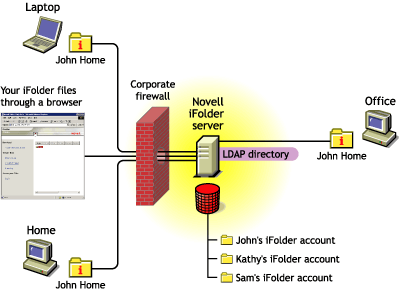2.0 Understanding the Novell iFolder Architecture
Novell® iFolder® 2.1 lets users manage files automatically. No matter where users choose to work, iFolder does all the file management for them. This means that even though users are working locally, all of their data is being securely uploaded and saved to the network. This data protection is automatic, secure, and transparent to users.
There are four pieces to Novell iFolder: the iFolder server software, the iFolder client software, the iFolder Java* applet (only for iFolder running on Windows 2000 and 2003 servers), and the Novell NetStorage. These pieces work together seamlessly to provide users with instant access to any iFolder files stored on their hard drives from anywhere in the world.
Figure 1 illustrates how the Novell iFolder server is accessed from different computers or locations. The iFolder server and storage component are central to the several access options.
For example, John authenticates to the iFolder server, using LDAPv3. John can access his iFolder data from home, work, or through a browser. When he works on a local computer, John is accessing his data locally. The iFolder server is responsible for making sure that all of John's computers have the latest version of his data. If he accesses his account through a browser, John is actually looking at the data that is stored on the iFolder server.
Figure 2-1 Typical iFolder Deployment Scenario

For information on the different access methods to use when accessing iFolder data, see the Novell iFolder 2.1 User Guide.
For information about synchronization, see Section 2.4, Authentication and Synchronization.